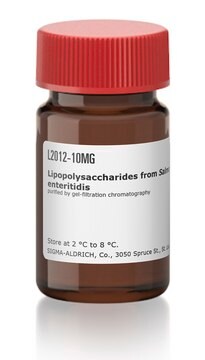L3137
Lipopolysaccharides from Escherichia coli O127:B8
purified by gel-filtration chromatography
Sinónimos:
LPS
Iniciar sesiónpara Ver la Fijación de precios por contrato y de la organización
About This Item
Productos recomendados
biological source
Escherichia coli (O127:B8)
Quality Level
form
lyophilized powder
purified by
gel-filtration chromatography
impurities
<1% Protein
color
white to yellow cast
solubility
water: soluble
shipped in
ambient
storage temp.
2-8°C
¿Está buscando productos similares? Visita Guía de comparación de productos
General description
This product is extracted from E. coli serotype O127:B8 and purified by gel filtration. The source strain is ATCC 12740. This LPS serotype has been used in the study of septic shock and to induce NOS in murine macrophages and PAF synthesis in rat glomerular masangial cells.
Application
Lipopolysaccharides (LPSs) are characteristic components of the cell wall of Gram-negative bacteria. LPS and its lipid A moiety stimulate cells of the innate immune system by the Toll-like receptor 4 (TLR4), a member of the Toll-like receptor protein family, which recognizes common pathogen-associated molecular-patterns (PAMPs).
Biochem/physiol Actions
Lipopolysaccharides (LPS) are localized in the outer layer of the membrane and are, in noncapsulated strains, exposed on the cell surface. They contribute to the integrity of the outer membrane, and protect the cell against the action of bile salts and lipophilic antibiotics.
Preparation Note
The product is soluble in water (5 mg/ml) or cell culture medium (1 mg/ml) yielding a hazy, faint yellow solution. A more concentrated, though still hazy, solution (20 mg/ml) has been achieved in aqueous saline after vortexing and warming to 70-80 oC. Lipopolysaccharides are molecules that form micelles in every solvent. Hazy solutions are observed in water and phosphate buffered saline. Organic solvents do not give clearer solutions. Methanol yields a turbid suspension with floaters, while water yields a homogeneously hazy solution.
Other Notes
To gain a comprehensive understanding of our extensive range of Lipopolysaccharides for your research, we encourage you to visit our Carbohydrates Category page.
Related product
Referencia del producto
Descripción
Precios
signalword
Danger
hcodes
Hazard Classifications
Acute Tox. 2 Oral
Storage Class
6.1A - Combustible acute toxic Cat. 1 and 2 / very toxic hazardous materials
wgk_germany
WGK 3
flash_point_f
Not applicable
flash_point_c
Not applicable
Elija entre una de las versiones más recientes:
¿Ya tiene este producto?
Encuentre la documentación para los productos que ha comprado recientemente en la Biblioteca de documentos.
Los clientes también vieron
Taichiro Nonaka et al.
The Journal of clinical investigation, 126(4), 1367-1382 (2016-03-15)
Most skin cancers develop as the result of UV light-induced DNA damage; however, a substantial number of cases appear to occur independently of UV damage. A causal link between UV-independent skin cancers and chronic inflammation has been suspected, although the
Evelin Painsipp et al.
PloS one, 6(6), e20719-e20719 (2011-06-16)
Immune challenge by bacterial lipopolysaccharide (LPS) causes short-term behavioral changes indicative of depression. The present study sought to explore whether LPS is able to induce long-term changes in depression-related behavior and whether such an effect depends on mouse strain and
Choon Kit Tang et al.
Biomaterials, 30(7), 1389-1400 (2008-12-09)
Receptor mediated gene delivery is an attractive non-viral method for targeting genetic material to specific cell types. We have previously utilized oxidized (OMPLL) and reduced mannan poly-L-lysine (RMPLL) to target DNA vaccines to antigen presenting cells and demonstrated that it
Eugene S Yim et al.
Journal of biomedical materials research. Part A, 91(3), 894-902 (2008-12-17)
Hydrogel polymers comprise a novel category of synthetic materials being investigated for use in cartilage replacement. One candidate compound, a poly(ethylene glycol)/poly(acrylic acid) (PEG/PAA) interpenetrating polymer network (IPN), was developed for use in corneal prostheses and was recently engineered for
Mitsuaki Moriyama et al.
Neurochemical research, 41(11), 3138-3146 (2016-11-04)
The biomolecule acetate can be utilized for energy production, lipid synthesis, and several metabolic processes. Acetate supplementation reduces neuroglial activation in a model of neuroinflammation induced by intraventricular injection of lipopolysaccharide (LPS). To investigate the mechanisms underlying the anti-inflammatory effect
Nuestro equipo de científicos tiene experiencia en todas las áreas de investigación: Ciencias de la vida, Ciencia de los materiales, Síntesis química, Cromatografía, Analítica y muchas otras.
Póngase en contacto con el Servicio técnico



